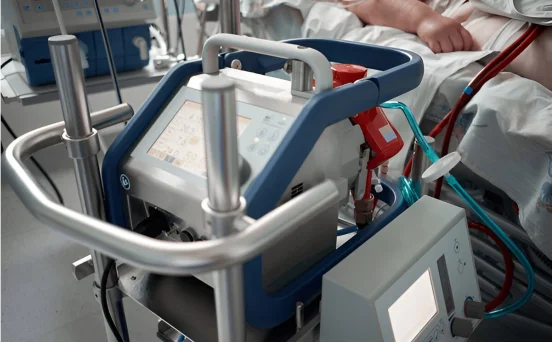Extracorporeal Membrane Oxygenation (ECMO) is an advanced life-support device that is used to treat patients whose lungs and hearts are unable to perform their functions independently. This advanced technology temporarily assumes the functions of the lungs and heart and delivers oxygen to blood vessels and removing carbon dioxide after traditional treatments do not work.
Extracorporeal Membrane Oxygenation (ECMO) is used primarily in respiratory and cardiac failure and respiratory failure, providing vital assistance for life-threatening illnesses like severe pneumonia, ARDS (Acute Respiratory Distress Syndrome) or cardiogenic shock or following certain cardiac surgery. It is a bridge to recuperation, transplant or other treatment by stabilizing the patient, and giving organs the chance to recover.
The procedure is usually employed for ICUs (ICUs) that require constant surveillance by a multidisciplinary team of specialists, comprising cardiothoracic surgeons, critical-care doctors and perfusionists.
Why is Extracorporeal Membrane Oxygenation Used?
Extracorporeal Membrane Oxygenation (ECMO) is not a primary treatment. It is only for those with grave, life-threatening heart and lung diseases that aren’t responding to the standard medical interventions such as mechanical ventilation, medication and oxygen therapy.
Key Situations Where ECMO is Used:
- A severe heart failure following procedure, heart attack or cardiomyopathy.
- Respiratory failure resulting from ARDS trauma, pneumonia or COVID-19.
- The bridge to transplant is for patients who are waiting for transplants of the heart or lungs.
- Support during surgeries that are high-risk or during the time of waiting for the outcome of reversible illnesses.
- Post-cardiac arrest assistance when other treatments fail.
The main objective in Extracorporeal Membrane Oxygenation (ECMO) is to maintain a healthy perfusion and oxygenation in the body. It also allows for the lungs and heart to recover, or for a subsequent interventions to be scheduled.
Symptoms That May Lead to Extracorporeal Membrane Oxygenation (ECMO) Use
ECMO is not recommended for minor illnesses. It is used when a patient is seriously sick. However certain signs or symptoms could be indicative of a more serious problem that may lead into the need for ECMO.
Common Symptoms Requiring Advanced Support:
- Breathlessness that is severe even when at the point of rest
- Very low blood oxygen levels (despite the high flow of oxygen and ventilation)
- Heart rate that is rapid or potentially low blood pressure
- Palpitations, chest pain and heart-related symptoms
- Alteration in mental state because of low oxygen levels
- Multi-organ failure or circulatory shock
These signs often signal the presence of a serious organ dysfunction. If it is not corrected rapidly, the issue could cause death. ECMO is diagnosed when symptoms get worse despite conventional therapies for intensive care.
Causes for ECMO Requirement
ECMO does not treat the illness it’s a way to support the body while the cause of the disease is treated. Recognizing and controlling the root cause is crucial for healing.
Common Conditions Leading to ECMO Use:
- Acute Respiratory Distress Syndrome (ARDS)
- Very severe Pneumonia (bacterial or virus, such as COVID-19)
- Heart attack (Myocardial infarction)
- Cardiogenic shock (a condition where the heart fails suddenly)
- Organ failure caused by Sepsis
- Massive embolisms of the lungs
- Post-cardiac surgery complications
- Congenital heart defect (in newborns and infants)
- Traumas that cause drowning or death to the lungs or the heart
The conditions cause hemodynamic instability or refractory hypoxemia When standard treatments are exhausted, ECMO becomes a viable alternative that could save lives.
Diagnosis: Determining the Need for ECMO
Before beginning ECMO Patients undergo an extensive diagnostic procedure to determine the severity and possibility of reversing their illness. ECMO is only started when it is believed to improve outcomes or act as a bridge to final treatment.
Diagnostic Steps Before ECMO:
- Arterial Blood Gas (ABG) Analysis
Analyzes carbon dioxide and oxygen levels in blood. If you have a constant Low PaO2 and/or high PaCO2 could indicate respiratory impairment. - Chest X-Ray / CT Scan
To identify lung diseases such as pneumonia ARDS as well as trauma. - Echocardiogram
Assesses the function of the heart, particularly when there is myocarditis or cardiogenic shock. - ECG (Electrocardiogram)
Look for heart attack warning signs. - Lab Tests
This includes kidney function, liver functions, infections markers levels of lactate, and coagulation profiles. - Hemodynamic Monitoring
It monitors your blood pressure, the oxygen level along with organ perfusion. - Ventilator Settings and Response
If the patient doesn’t respond to a high PEEP, prone position or nitric oxide treatment ECMO might be a possibility.
A multidisciplinary team reviews the patient’s medical the patient’s history functioning of the organ, co-morbidities and the possibility of a successful healing before putting an individual patient onto ECMO.
Treatment: How Does ECMO Work?
Types of ECMO:
- Veno-Arterial (VA-ECMO):
- Supports both heart and lungs
- In the event of cardiac failure, post-cardiac arrhythmias or in cardiogenic shock
- Veno-Venous (VV-ECMO):
- Only supports lungs.
- Common In ARDS and severe pneumonia
How ECMO Works:
- The blood is withdrawn from the body via the cannula (tube) which is inserted into an extensive vein.
- It’s passed by a membrane-oxygenator in which it is oxygenated, and carbon dioxide removed.
- The oxygen-rich blood then transferred to the human body through the vein (VV-ECMO) or an artery (VA-ECMO).
Monitoring and Care:
Patients who are on ECMO need:
- Monitoring of continuous oxygenation levels, perfusion and organ functioning.
- Anticoagulation therapy (usually the use of heparin) to prevent the formation of clots in the circuit.
- Regular imaging and labs to track the circuit cannula’s position, and the patient’s response.
The time frame for Extracorporeal Membrane Oxygenation (ECMO) Patients recover differently. Some patients heal within a few days and others could require weeks. Removing from Extracorporeal Membrane Oxygenation (ECMO) occurs when the heart and/or lungs are able to operate independently.
Conclusion
Extracorporeal Membrane Oxygenation is not a cure, but rather an essential support system for patients suffering from critical lung or heart disease. In cases where other options are not working, Extracorporeal Membrane Oxygenation (ECMO) provides the body with the oxygen it needs and circulatory assistance, giving time to heal, making decisions or transplantation.
The prompt diagnosis, the patient’s selection, and skilled ICU care are vital for maximizing the effectiveness of Extracorporeal Membrane Oxygenation (ECMO) . Although it’s complicated and requires a lot of resources, Extracorporeal Membrane Oxygenation (ECMO) has transformed outcomes for patients who had no hope of surviving.























